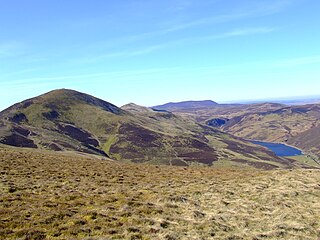Pentland Hills


The Pentland Hills are a range of hills to the south-west of Edinburgh, Scotland. The range is around 20 miles in length, and runs south west from Edinburgh towards Biggar and the upper Clyde Valley.
Some of the peaks include:
- Scald Law (579 m)
- Carnethy Hill (573 m)
- West Cairn Hill (562 m)
- East Cairn Hill (561 m)
- Byrehope Mount (536 m)
- Allermuir Hill (493 m)
The hills span a number of council regions: from City of Edinburgh and Midlothian in the north, south-west through West Lothian to Scottish Borders and South Lanarkshire. In fact, the Pentlands are more or less the historic natural boundary between West and Midlothian.
Usage



Pentland Hills Regional Park was designated in 1984, it covers an area of 90 km² at the northern end of the hills. The park, together with the rest of the hills, are used for a variety of recreations including hillwalking, mountain biking, horse riding, golf and skiing at the artificial ski slope at the Hillend Ski Centre.
Today most of the land is upland pasture, along with a few forestry plantations. The Ministry of Defence have a rifle range at Castlelaw. Much of Edinburgh's water supply is from reservoirs in the hills, including Threipmuir, Harlaw, Clubbiedean, Torduff, Glencorse and Loganlea. A number of rivers begin in the hills, including the Water of Leith and the North Esk.
The recording studio of the band Boards of Canada, known as Hexagon Sun is said to be located somewhere in the Pentland Hills, although its existence has not been proven.
In the southern part of the hills is Little Sparta, the garden of the late artist and poet Ian Hamilton Finlay.
Settlements in or near the Pentlands include:
- Edinburgh suburbs - Balerno (with Malleny Mills), Juniper Green, Colinton, Currie, Oxgangs, Fairmilehead, Swanston
- Midlothian - Glencorse, Hillend, Nine Mile Burn, Penicuik, Silverburn,
- West Lothian - Kirknewton, Livingston is also near.
- Scottish Borders (traditional Peebleshire) - Carlops, West Linton
- South Lanarkshire - Auchengray, Carnwath, Dolphinton, Dunsyre, Garvald, Tarbrax
History
There is ample evidence of prehistoric settlement in the area, e.g. the hillfort at Castlelaw, and another at Caerketton.
The hills were the scene of an incident in 1666 following the Restoration of King Charles II when an outbreak of armed rebellion amongst Covenanters led to a small force of badly armed conventiclers being defeated at the battle of Rullion Green, after which the whole tragic episode was (incorrectly) named the Pentland Rising. The incident is commemorated by the "Covenanter's Grave", a cairn after which one of the drove roads across the hills is known (OS Grid reference NT078521).
External links
Further reading
- The Pentland Hills - A Walker's Guide, Susan Falconer. Cicerone 2007 ISBN 978 1 85284 494 3

